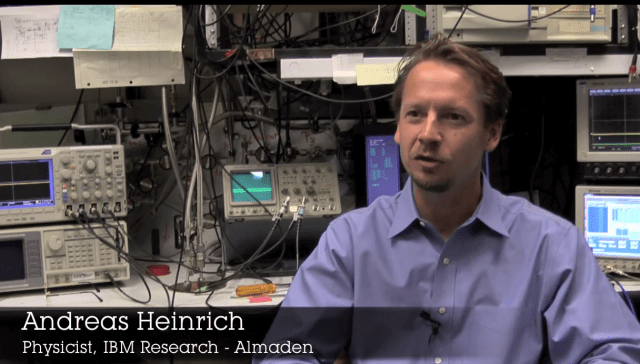IBM Research is focusing on innovation not for tomorrow, but for the much broader future. Today, it was able to shrink down the amount of atoms we use in memory drives from millions to 12.
[aditude-amp id="flyingcarpet" targeting='{"env":"staging","page_type":"article","post_id":375672,"post_type":"story","post_chan":"none","tags":null,"ai":false,"category":"none","all_categories":"business,","session":"C"}']“We’re trying to answer a simple question,” said IBM Research physicist Andreas Heinrich in an interview with VentureBeat. “How small can you make a magnetic structure and still make it useful for data storage?”
The answer the IBM scientists came upon was 12. This grouping of atoms, while dramatically reduced, still behaves in the same ways our memory drives do to grab and store information. They were able to accomplish this by using antiferromagnets. These are very different from traditional magnets. A ferromagnetized atom acts the same as the magnets you put on your refrigerator — if one atom in this magnet is polarized north, all its neighboring magnets will also be polarized north, giving off a magnetic field, or that resistance you feel when you try to put two magnets together. But if an antiferromagnetic atom is polarized north, its direct neighbor is polarized south. This allows these magnets to sit much closer together, as it does not give off the same field.
AI Weekly
The must-read newsletter for AI and Big Data industry written by Khari Johnson, Kyle Wiggers, and Seth Colaner.
Included with VentureBeat Insider and VentureBeat VIP memberships.
Because scientists need special tools to handle these atoms, you’re not going to see them in a store anytime soon. In fact, in order to use the tool at all, you must be in low temperatures, not suited for data centers. To operate at room temperature would mean upping the amount of atoms from 12 to 150. But this isn’t the goal for Heinrich. For him, it’s about showing the world what is possible.
“Here at IBM, most of all people are working on making products that are slightly better than the last one,” said Heinrich. “The work that I’m working on is not in that realm. We’re doing exploratory research.”
The research gives a glimpse of what the future may look like with more development and more research. It seems that other than our televisions, we are constantly trying to shrink down products to make them smaller, more efficient. This includes data centers, with companies like Fusion-io bent on turning a data center from a roomful of server racks into just a single rack. But these innovations will take time, and Heinrich stresses that we should be focusing less on days, but rather on decades.
“We currently in our society are too focused on whats going to happen tomorrow,” he said. “We want to have a strong focus on what’s going to happen in 10 years.”
VentureBeat's mission is to be a digital town square for technical decision-makers to gain knowledge about transformative enterprise technology and transact. Learn More

